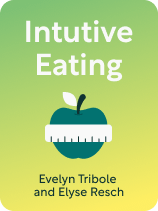

This article is an excerpt from the Shortform book guide to "Intuitive Eating" by Evelyn Tribole and Elyse Resch. Shortform has the world's best summaries and analyses of books you should be reading.
Like this article? Sign up for a free trial here.
Why is listening to your body important for your health? How can you recognize hunger cues in adults?
To free yourself from the pressure to diet, you should practice listening to your body’s hunger and fullness cues. Intuitive Eating by Evelyn Tribole and Elyse Resch says that this practice helps you notice and fulfill your hunger, as well as prevents you from overeating.
Find out how to recognize physical and emotional hunger cues in adults.
Listen to Your Body’s Hunger and Fullness Cues
The authors offer the following advice for tuning in to hunger cues in adults:
1) Practice mindful eating by assessing your hunger levels before, during, and after each meal. This allows you to become more aware of how much and how often your body requires nourishment.
(Shortform note: Mindful eating experts suggest that understanding seven different types of hunger helps you assess hunger levels by differentiating between genuine physical hunger and other triggers for eating: 1) Stomach hunger—the physical hunger felt when the body needs nourishment. 2) Eye hunger—the desire for food stimulated by seeing delicious-looking dishes. 3) Nose hunger—cravings triggered by the aroma of food. 4) Mouth hunger—craving specific tastes or textures. 5) Mind hunger—emotional or psychological hunger driven by stress or boredom. 6) Heart hunger—longing for emotional connection or comfort, sometimes fulfilled through food. 7) Cellular hunger—a deeper need for essential nutrients.)
2) Pay attention to bodily sensations that indicate hunger, such as a grumbling stomach or low energy levels. When you experience a hunger cue, eat promptly to avoid excessive hunger—being too hungry makes it challenging to discern what food your body needs and when it’s had enough.
(Shortform note: Experts suggest that paying attention to bodily sensations helps you distinguish between hunger and appetite. Hunger is a physiological response driven by biological needs to maintain energy levels. On the other hand, appetite is the desire to eat, often influenced by emotions or external factors. One way to differentiate between the two is to observe your reaction to a nutritious dish you don’t particularly enjoy. If you would willingly eat it, it’s likely true hunger. However, if you find yourself craving a specific indulgence instead, such as a slice of rich chocolate cake, it’s more likely appetite.)
3) Ensure easy access to food by preparing meals and snacks in advance. This eliminates feelings of deprivation that trigger overeating because you can confidently stop eating when you’ve had enough, knowing that you can meet your body’s needs whenever hunger arises.
(Shortform note: While the idea of preparing food in advance may appear to contradict the advice to eat only according to your body’s hunger cues and needs, there is a way to align both approaches and stay true to your body’s internal signals. When meal prepping, plan your meals for the week with a flexible mindset, focusing on creating a variety of options that appeal to your individual tastes and preferences. This allows you to have easy access to choices while remaining open to your body’s changing needs and cues. Trusting your instincts and honoring your hunger and fullness cues will guide you in selecting the right meal from your prepped options, promoting a balanced and satisfying eating experience.)
4) Consume food every three to four hours. This practice is particularly beneficial if you’ve lost touch with your body’s natural hunger cues—consistent meal patterns can help your body regain a reliable sense of hunger.
(Shortform note: While experts acknowledge that the optimal time between meals varies depending on factors like activity level, state of health, and nutritional needs, they agree that eating regularly offers multiple health benefits. Regular meals stabilize blood sugar levels and sustain energy levels, prevent extreme hunger and overeating, improve metabolism, enhance focus and concentration, aid digestion, and reduce discomfort after eating. Additionally, structured meal times encourage mindful eating, fostering a more balanced and mindful approach to nourishing your body.)
Distinguish Between Physical and Emotional Hunger
In addition to listening to your body’s hunger and fullness cues, practice distinguishing between physical and emotional hunger. This will help you recognize when you may be using food to fulfill needs other than physical nourishment. For example, you may be using it as a coping mechanism for emotional discomfort or as a means of distraction.
According to Tribole and Resch, recognizing how you use food to address your emotional needs offers two significant benefits: First, it enables you to make more conscious eating choices based on your body’s physical cues, allowing you to respond to genuine hunger signals. Second, it empowers you to explore alternative and more fulfilling ways to meet your emotional needs, freeing yourself from relying solely on food.
They suggest that you identify your emotions when you catch yourself eating when you’re not physically hungry. This can involve various techniques such as sitting with your emotions and experiencing them, journaling to express and understand your feelings, or confiding in someone you trust to gain clarity.
Once you’ve identified your emotions, ask yourself what you need to do to address your feelings. Then find healthy and appropriate ways to meet those needs beyond turning to food. For example, you might be feeling frustrated and in need of physical exercise, or you might be feeling bored and require mental stimulation, or you might be feeling sad and could benefit from a comforting hug.
Mindfulness Helps Uncover the Root Cause of Emotional Eating
Mindfulness experts offer additional insights that can aid in recognizing and overcoming emotional eating patterns. They identify four categories of emotions that people often try to alleviate by engaging in habits such as emotional eating:
- Wanting: eating food in an attempt to feel better emotionally
- Distracting: eating food as a way to avoid facing negative emotions or experiences
- Resisting: eating food as a protective shield against facing or acknowledging certain emotions
- Doing: eating food as a means to keep busy and regain a sense of control
By becoming more mindful of the specific emotions driving your desire to eat, you can gain a deeper understanding of your emotional patterns. This awareness will empower you to explore healthier alternatives to effectively address those emotions.

———End of Preview———
Like what you just read? Read the rest of the world's best book summary and analysis of Evelyn Tribole and Elyse Resch's "Intuitive Eating" at Shortform.
Here's what you'll find in our full Intuitive Eating summary:
- Why eating is often associated with guilt, shame, and fear
- How diets damage your relationship with food
- Ways to cultivate a healthy relationship with food






